Octet rule Study guides, Class notes & Summaries
Looking for the best study guides, study notes and summaries about Octet rule? On this page you'll find 405 study documents about Octet rule.
Page 2 out of 405 results
Sort by
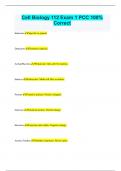
-
Cell Biology 112 Exam 1 PCC 100% Correct
- Exam (elaborations) • 13 pages • 2024
- Available in package deal
-
- $9.99
- + learn more
Cell Biology 112 Exam 1 PCC 100% Correct Induction Specific to general Deduction General to specific Archae/Bacteria Prokaryote. One-cell. No nucleus. Eukarya Eukaryotes. Multi-cell. Has a nucleus. Protons Found in nucleus. Positive charged. Nuetrons Found in nucleus. Neutral charge. Electrons Found in outer shells. Negative charge. Atomic Number Number of protons. Never varies. Atomic Mass Number of protons and neutrons in the nucleus. To determine number of nue...
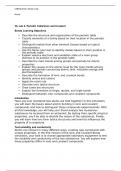
-
CHEM 120 Week 2 Virtual Lab; Periodic Table of Elements Part I,Part II
- Other • 6 pages • 2023
- Available in package deal
-
- $20.99
- + learn more
Objectives • Describe the structure and organization of the periodic table • Classify elements of a family based on their location in the periodic table • Distinguish metals from other element classes based on typical characteristics • Use the flame color test to identify metals based on their position in the periodic table • Explain valence electrons and oxidation state of a main group element to its position in the periodic table • Describe the main trends among groups and pe...
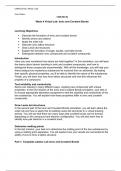
-
CHEM 120 Week 2 Virtual Lab; Ionic and Covalent Bonds Part 1, Part II
- Other • 3 pages • 2023
- Available in package deal
-
- $20.99
- + learn more
Learning Objectives • Describe the formation of ionic and covalent bonds • Identify anions and cations • Apply the octet rule • Describe ionic lattice structure • Draw Lewis dot structures • Explain the formation of single, double, and triple bonds • Distinguish between ionic compounds and covalent compounds Introduction Have you ever wondered how atoms are held together?
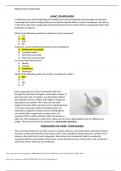
-
CHEM 120 Week 2 Ionic Compounds
- Other • 8 pages • 2024
-
- $22.49
- + learn more
Week 2 Ionic Compounds IONIC COMPOUNDS In this lesson, you will be exploring ionic bonding. You have encountered many examples of molecules containing Ionic bonds including table salt and sodium fluoride which is found in toothpaste. We will see in this lesson how ionic compounds are formed and how the formation of these compounds leads to the properties we observe. Which of the following would be considered an Ionic Compound? A. CH4 B. LiCl C. N2O4 D. SO In general, an ionic bond for...
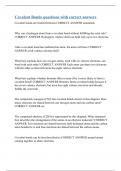
-
Covalent Bonds questions with correct answers
- Exam (elaborations) • 3 pages • 2023
-
- $11.99
- + learn more
Covalent bonds are formed between CORRECT ANSWER nonmetals Why can a hydrogen atom form a covalent bond without fulfilling the octet rule? CORRECT ANSWER Hydrogen's valence shell can hold only up to two electrons. After a covalent bond has stabilized an atom, the atom will have CORRECT ANSWER a full valence electron shell. What best explains how two oxygen atoms, each with six valence electrons, can bond with each other? CORRECT ANSWER Each atom can share two electrons with the other s...
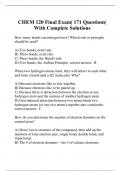
-
CHEM 120 Final Exam| 171 Questions| With Complete Solutions
- Exam (elaborations) • 47 pages • 2023
- Available in package deal
-
- $15.99
- + learn more
How many bonds can nitrogen have? Which rule or principle should be used? A) Five bonds; octet rule. B) Three bonds; octet rule. C) Three bonds; the Hund's rule. D) Five bonds; the Aufbau Principle. correct answer: B When two hydrogen atoms meet, they will attract to each other and form a bond (and a H2 molecule). Why? A) Because electrons like to stay together. B) Because electrons like to be paired up. C) Because there is attraction between the electron in one hydrogen atom an...
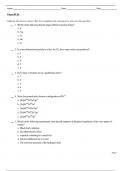
-
Test Bank for Chemical Principles, 8th Edition by Peter Atkins
- Exam (elaborations) • 558 pages • 2024
-
- $39.49
- + learn more
Test Bank for Chemical Principles: The Quest for Insight 8e 8th Edition by Peter Atkins; Loretta Jones; Leroy Laverman; Kelley Young; James Patterson. Full Chapters are included (Focus 1 to Focus 10 are included) Focus 1: Atoms 1A Investigating atoms 1B Quantum theory 1C Wavefunctions and energy levels 1D The hydrogen atom 1E Many-electron atoms 1F Periodicity Focus 2: Bonds Between Atoms 2A Ionic bonding 2B Covalent bonding 2C Beyond the octet rule 2D The properties of bonds 2...
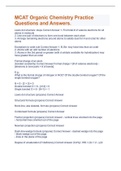
-
MCAT Organic Chemistry Practice Questions and Answers.
- Exam (elaborations) • 50 pages • 2023
-
- $8.99
- + learn more
Lewis dot structure: steps Correct Answer 1. Find total # of valence electrons for all atoms in molecule 2. Use one pair of electrons to form one bond between each atom 3. Arrange remaining electrons around atoms to satisfy duet for H and octet for other atoms Exceptions to octet rule Correct Answer 1. B, Be: may have less than an octet 2. Atoms with an odd number of electrons 3. Atoms in the 3rd period or greater (with d orbitals available for hybridization) may have greater than an octe...
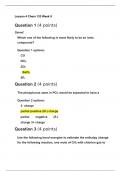
-
CHEM133 Week 9 Lesson 4 Quiz
- Exam (elaborations) • 12 pages • 2023
- Available in package deal
-
- $29.99
- + learn more
1. Question: Which one of the following is most likely to be an ionic compound? 2. Question: The phosphorus atom in PCl3 would be expected to have a 3. Question: The phosphorus atom in PCl3 would be expected to have a give CH3Cl and hydrogen chloride. 4. Question: How many of the following molecules have no dipole moment? 5. Question: Atoms having equal or nearly equal electronegativities are expected to form 6. Question: Element A has an electronegativity of 0.8 and element B has an electr...
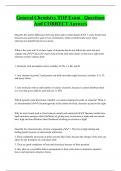
-
General Chemistry TOP Exam Questions And CORRECT Answers
- Exam (elaborations) • 65 pages • 2024
-
- $9.99
- + learn more
Describe the atomic differences between Ionic and Covalent bonds. 1. Ionic bonds form between ions and involve gain or loss of electrons, while covalent bonds occur when electrons are shared between two atoms What is the octet rule? List three types of elements that do not follow the octet rule and explain why. Octet rule=atoms tend to bond with other atoms so they have eight outer electrons in their valence shell 1. Elements with incomplete octets, includes: H, He, Li, Be, and B. 2. ...



